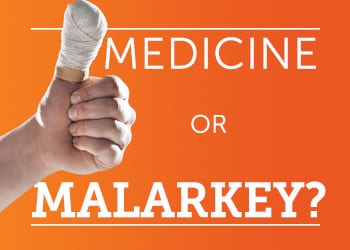Medicine or Malarkey: Does the R.I.C.E. Method Help Muscle or Other Soft Tissue Injuries?
October 16, 2014

For as long as we can remember, injuries like sprains, strains and muscle aches were often treated with the R.I.C.E. method — rest, ice, compression and elevation. But, is this the best way to treat these aches and pains? Well, the answer is a bit murky.
In fact, experts are now questioning the R.I.C.E. method, especially the use of ice to prevent inflammation. Even Dr. Gabe Mirkin (the doctor who coined the phrase back in 1978) is now backing away from this method. Why? New research from The American Journal of Sports Medicine and other experts suggest that cooling down an injured area for more than short-term increments doesn’t speed up recovery. In fact, over-icing might actually slow down the healing process.
How does ice slow down the healing process?
Although cooling with ice immediately following a muscle or other soft tissue injury may delay swelling and temporarily relieve pain, it may actually delay the healing process in the long term. Here’s what researchers have discovered:
- Believe it or not, inflammation is actually good for healing! The process of inflammation allows your immune system to send cells and proteins to the injured tissue — this jump starts the healing process by releasing a special hormone called IGF-1.
- Ice prevents healing cells from reaching injured tissue. A 2013 study by The Journal of Strength & Conditioning Research suggests that cooling delays recover from muscle damage. When ice is applied to injured tissue, blood vessels constrict and decrease blood flow. That means the helpful cells sent to an injured site through the inflammation process can’t get through properly, which can prolong the injury and even cause nerve damage. Applying ice prevents the body from releasing the hormone needed for healing.
- Ice can reduce strength, speed, endurance and coordination. According to a 2011 study by Sports Med, cooling for more than 20 minutes decreases an athlete’s ability to function properly — it can slow their movements and reduce athletic efficiency. One solution: try icing for less than 10 minutes at 20-minute intervals, and no more than once or twice, then follow this with a short warm-up period before returning to the athletic activity.
- Ice isn’t the only thing that can inhibit the healing process. You should also avoid anything else that reduces inflammation for long periods, including pain-relieving medications (like Tylenol, Advil, etc.), immune suppressants, and topical cortisone creams (like Neosporin). Anything that prevents your immune system from kicking in quickly will delay your recovery efforts.
What should I do after a muscle or other soft tissue injury?
The remaining parts of R.I.C.E. still apply. Dr. Mirkin’s recommendations are as follows:
- If you are injured, stop exercising immediately.
- Clean and bandage open wounds. If the injury is limited to muscles or other soft tissue, a medical professional, physical trainer or coach may apply a compression bandage to compress the area.
- Determine that no bones are broken and that movement will not increase damage.
- Elevate the injured area to minimize swelling.
- You can use ice to reduce swelling and decrease pain immediately following a minor muscle or other soft tissue injury, but only if you follow these guidelines:
- Apply the ice for no more than 5–10 minutes. Remove it for 20 minutes. Repeat the 10-minute application once or twice. There is no reason to apply ice more than six hours after you have injured yourself.
- Seek emergency medical attention if the pain is severe, if you are unable to move, or if you lose consciousness. For life-threatening emergencies, always call 911.
- Exercise the injured tissue. As soon as it’s possible to get moving again safely without causing more pain or discomfort, you should attempt basic exercises to stretch and engage the injured muscle, strengthening it slowly for use. However, always follow the advice of your preferred medical professional regarding rehabilitation.
So what’s the verdict? For acute soft tissue injuries, researchers conclude that more scientific study is needed to provide more evidence-based guidelines. If you experience minor muscle strains, sprains or soft tissue injuries, you can visit your nearby CareSpot for same-day treatment.
CareSpot Locations and Services
If you are injured, CareSpot is here to help. Find a CareSpot location near you for help with:
- Auto accident injuries
- Digital X-rays
- Pulled or strained muscles
- Sprains or minor fractures
- On-the-job injuries
- And more
